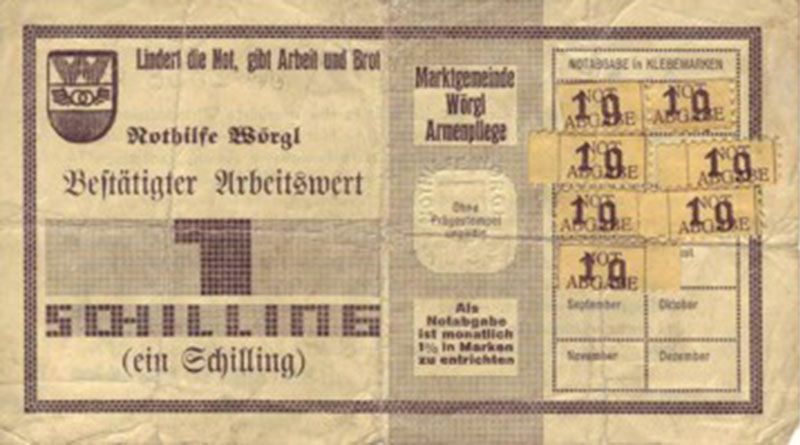The miracle of Wörgl
The Austrian town of Wörgl, with a population of 4,500 people, offers the base of a viable economic plan in this story during the 1932 Great Depression.

In 1932, in the middle of the Great Depression, the Austrian town of Wörgl was in deep trouble and prepared to try anything. Of its population of 4,500, a total of 1,500 people were without a job, and 200 families were penniless. Mayor Michael Unterguggenberger had a long list of projects he wanted to accomplish, but there was hardly any money to carry them out. These projects included paving roads, streetlights, extending water distribution across the whole town, and planting trees along the streets.1 2
Rather than spending the 32,000 Austrian Schilling in the town’s coffers to start these projects off, he deposited them in a local savings bank as a guarantee to back the issue of a currency known as stamp scrip. The Wörgl money required sticking a monthly stamp on the circulating notes to keep them valid, amounting to 1% of the note’s value.1 2 A businessman named Silvio Gesell came up with this idea in his book The Natural Economic Order.
Nobody wanted to pay for the monthly stamps, so everyone receiving the notes would spend them. The 32,000 schilling deposit allowed anyone to exchange scrip for 98 per cent of its value in schillings. Hardly anyone did this because the scrip was worth one schilling after buying a new stamp. But people did not keep more scrip than they needed. Only 5,000 schillings circulated. The stamp fees paid for a soup kitchen that fed 220 families.1 2
The council carried out all the intended works, built new houses, a reservoir, a ski jump and a bridge. The key to this success was the fast circulation of the scrip money within the local economy, fourteen times higher than the Schilling. This increased trade and employment. Unemployment in Wörgl dropped 25% while it rose in the rest of Austria. Six neighbouring villages copied the idea successfully. The French Prime Minister, Édouard Daladier, visited the town to witness the ‘miracle of Wörgl’ himself.1 2
In January 1933, the project was copied in the neighbouring city of Kitzbühel. In June 1933 major Unterguggenberger addressed a meeting with representatives from 170 different Austrian towns and villages. Two hundred Austrian townships were interested in the idea. At this point the central bank decided to assert its monopoly rights by banning scrip money.1 2
The local currency of Wörgl demonstrates that the economy can do well without more debt if money keeps circulating. Negative interest rates can make that happen. Stamps on money like in Wörgl make negative interest rates possible as you can avoid paying for stamps by lending out money. For instance, lending out money at a negative interest rate of 2% per year would be more attractive than paying for the stamps. Negative interest rates might have prevented the depression or ended it once it had started. So if scrip had been money in the 1920s and 1930s, World War II might never have happened.
Read the full article at the original website.
References:
- The Future Of Money. Bernard Lietaer (2002). Cornerstone / Cornerstone Ras.
- A Strategy for a Convertible Currency. Bernard A. Lietaer, ICIS Forum, Vol. 20, No.3, 1990.
